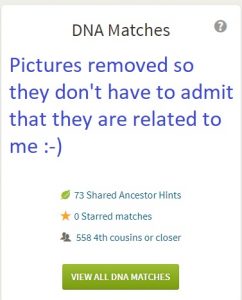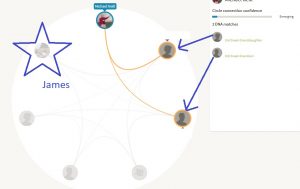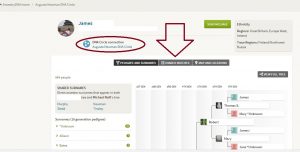 If one navigates the circles at AncestryDNA, one can view the shared DNA matches one has not only with your own DNA matches, but also for those people who are in your DNA circle as well–but are not a DNA match to you. For reasons that elude me, I never noticed this until today. This functionality allows me to see DNA matches of people to whom I am related, but with whom I am not a DNA match. That’s good because not every genealogical cousin will share significant DNA with me. Seeing matches that I share with a known cousin who is not a DNA match themselves can help me to sort and sift my matches.
If one navigates the circles at AncestryDNA, one can view the shared DNA matches one has not only with your own DNA matches, but also for those people who are in your DNA circle as well–but are not a DNA match to you. For reasons that elude me, I never noticed this until today. This functionality allows me to see DNA matches of people to whom I am related, but with whom I am not a DNA match. That’s good because not every genealogical cousin will share significant DNA with me. Seeing matches that I share with a known cousin who is not a DNA match themselves can help me to sort and sift my matches.
James (we will just refer to him by his first name) is descendant of Augusta Newman (who died in 1864 in White County, Indiana) as am I. We have corresponded off and on for probably fifteen or twenty years.
James has done a DNA test at AncestryDNA. We are not a DNA match. That’s not surprising as Augusta is fairly back for both of us–he’s my 4th great-grandfather.
However, James and I are both in the AncestryDNA circle for Augusta Newman. We got in the circle for Augusta because:
- we have our trees tied to our AncestryDNA results
- we both show Augusta Newman as an ancestor in our tree
- we both match other people who have this same Augusta in their tree.
James is not one of my matches, so I can’t browse his common matches with me by viewing him on my list of matches. He is one of several others in the AncestryDNA circle for Augusta Newman who are not a DNA match to me.

If I click on James’ name in the circle, I see a little bit more about him to the right hand of the circle. I can then click on his name and pull up his AncestryDNA information (or at least what I’m allowed to see from other users):

I can’t view the “shared DNA” information (in the oval area on the illustration), but I can see those matches that James and I have in common.
I cannot automatically assume that these DNA matches I share with James automatically descend from Augusta Newman. Their genealogical pedigree connection with me may be further back in Augusta’s pedigree. Or it may not. If we all descend from people who lived in the same area for generations, it may be that one of these shared matches I have with James doesn’t even connect with me through Augusta Newman in any way at all. The DNA match and I may descend from one of Augusta’s neighbors who is not James’ ancestor.

7 Responses
Wow! That’s mighty interesting information to sink my brain into. Thank u 4 this .
I will preface this ny saying that I value DNA testing for my research and use it quite a bit, so I’m not knocking it at all. But… sometimes I wonder how often (or not often) DNS results that don’t match when you expect them to is because someone’s biological parent (father) is not who we assume it to be. If a woman had a secret tryst with a neighbor, perhaps, or maybe a man forced himself on a woman when the husband wasn’t around, resulting in a pregnancy where the woman kept quiet about the situation, leading all to assume it was her husband’s child. That kind of situation would have been extremely tabu in days gone by, and women certainly would have been less likely to share what had happened, even with friends and family.
I’ve wondered that as well…and those situations where maybe the first child was not the husband’s and everyone “knew it” but the husband raised that child as his own.
Sometimes these things don’t always result in records at all. My children’s great-great-grandmother apparently had a short-term relationship in between her second and fourth child that resulted in my children’s great-grandmother. Great-great-grandmother would tell this child that she had a different father…never saying who he was. Analyzing the DNA matches is consistent with this the great-great-grandmother’s “statements” and has suggested that the biological father is one of three brothers.
Thank you Anne- that’s how I am here!
Hi Micheal, I’m also just started looking at “Shared Matches” on Ancestry.com. I still haven’t gotten through all my DNA match pages (958 4th cousins or closer and growing). I don’t bother looking at a match with less than 100 people. I’ve found that there is usually no way to go back far enough to find the connection (a couple of good exceptions when I recoginze the last name).
So the DNA Circles have been great for me. I’ve even contacted close cousins and told them how to get in a particular circle. Most of them need to extent their family tree, not follow just parent to parent. When I go back 3-4 generations there were sometimes 12 or more children, so there will be lots of “sidelines” to follow down to our generation.
You can also go into trees you have connected to -to view- and trees connected to them, starting out in your tree. I’ve “poked around” that way for years and compared different people’s trees and the sources for years. It’s similar to looking at the people who are not a DNA connection.
And today I saw a really exciting website called DNA Painter. I am a “visual learner”-give me graphics, maps, diagrams, geometry!!! I am not much for spread sheets. I have also very recently put my raw DNA onto other sites for free and added a GEDCOM.
But, there is still much to do on research trips. I am very grateful we have so much available online to us.
I should have added another way to search your Ancestry.com DNA matches. Maybe you have already done this or addressed it.
1. Go to the DNA Summary. 2. Go to “View All DNA Matches”. 3. On the right-hand side, near the top of the page is “Search Matches” in a blue box, click on that. (This is a filter.) 4. On the left side is “Search by surname”, with “Include similar surnames” box you can check or not. I started with my direct line names and then have branched out to associated names. This pulls in anyone with that surname in their family tree.
This gives me a really targeted method to look at family trees, instead of a shotgun approach by going down the list in the summary, especially since I know most of the time which branch of my family tree these names belong to. There are some surnames that appear in two or more branches since they were in the same geographical area early on. So far, they are not closely related to each other.
That’s a good idea. I think it’s been mentioned somewhere in passing, but it’s a good idea. Of course it only finds those who have trees, but it’s a good way to start. And those who are treeless and distant matches can be difficult to figure out–especially one starts with them.